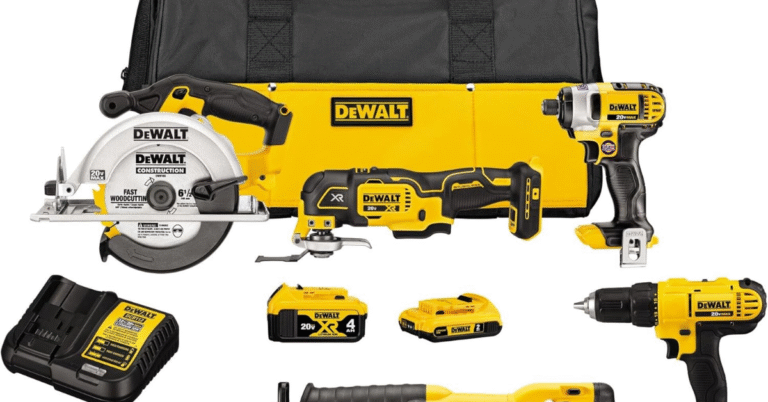Tool Prices 2025: Why Your Favorite Tools Cost 25% More This Year
Tool prices 2025 have surged due to a perfect storm of trade wars, material shortages, and manufacturing disruptions. While tariffs grab headlines, the reality behind tool prices 2025 is more complex and the impact on your wallet is just beginning.
Remember when you could grab a decent cordless drill for under $100?
Those days feel like ancient history now. Walk into any Home Depot or Lowe’s today and you’ll experience some serious sticker shock. That trusty DeWalt drill that used to cost $120 is now demanding $150 of your hard-earned cash. The Milwaukee impact driver you’ve been eyeing? It’s jumped 20% since last year, and it’s not coming back down anytime soon.
If you’re scratching your head wondering what happened to reasonable tool prices 2025, you’re definitely not alone. The answer involves a tangled web of global economics, trade disputes, and supply chain chaos that makes a box of mixed screws look organized by comparison.
➤ Need help choosing the best value tools? Check out our Complete Tool Reviews & Comparisons to make smart purchases despite rising prices.
The Perfect Storm Behind Tool Prices 2025
Multiple factors are ganging up on tool prices 2025 like a crew of overzealous contractors on a rush job. Current tool prices 2025 are climbing due to tariffs, labor shortages, shipping nightmares, and skyrocketing costs for materials like lithium and steel. Some brands are also raising prices just to keep their profit margins from disappearing faster than your 10mm socket.
The truth is, blaming everything on tariffs is like saying your project failed because of one stripped screw. Sure, it didn’t help, but there’s a whole lot more going wrong under the hood when it comes to tool prices 2025.
➤ Wondering which brands offer the best value? Read our Expert Tool Guides & Reviews to see how major brands stack up.
Trade Wars: More Than Just Political Theater
While tariffs make great newspaper headlines, they’re only part of this expensive puzzle. Manufacturing disruptions, labor costs, and global logistics disasters are doing just as much damage to your wallet. The trade tensions with China hit especially hard when you realize that Milwaukee, America’s favorite “tough guy” brand, is actually owned by Techtronic Industries (TTI), a Hong Kong company with massive manufacturing operations in China. Plot twist, right?
DeWalt might feel more American with its yellow and black colors, but even though Stanley Black & Decker owns the brand, most DeWalt tools come together using components from Mexico, China, and various other countries. It’s like a global potluck dinner, except instead of bringing casseroles, everyone’s bringing supply chain headaches.
Material Costs Going Through the Roof
Raw material prices are behaving like a toddler on a sugar high, completely unpredictable and mostly unpleasant. Lithium, the star ingredient in all those cordless batteries we love, has been on a price roller coaster that would make Six Flags jealous. Steel costs are bouncing around more than a dropped tape measure on concrete. These aren’t tiny price bumps that manufacturers can shrug off. We’re talking about cost increases so significant that even the bean counters are reaching for antacids.
The Great Labor Shortage Saga
Tool companies are desperately trying to find skilled workers like contractors hunting for parking at Home Depot on Saturday morning. Many factories are running with skeleton crews or frantically installing robots to do jobs that humans used to handle. This automation push costs serious money upfront, and guess who gets to fund that technological upgrade? Spoiler alert: it’s you, the tool buyer.
Even repair and warranty departments are feeling the squeeze, which explains why getting your favorite drill fixed takes longer than waiting for your permit approval.
Shipping Costs That Make You Cry
Remember when shipping was cheap and fast? Those golden days disappeared faster than your measuring tape when you need it most. Shipping costs shot through the stratosphere during the pandemic and decided they liked the view up there. While they’ve come down from their absolute peak, they’re still camping out at levels that make pre-2020 pricing look like clearance sale prices. Add in port delays, trucking shortages, and fuel costs that swing more than a pendulum, and you’ve got a logistics nightmare that would challenge even the most organized contractor.
The Ironic Market Reality
Here’s where things get really interesting regarding tool prices 2025. Despite all the cool innovations happening in the tool world (and there are some seriously impressive new gadgets), power tool sales are expected to take a nosedive in 2025. Both professional contractors and weekend warriors are tightening their tool budgets, creating a situation where manufacturers need to squeeze more profit from fewer sales to justify current tool prices 2025.
It’s like trying to make the same money by selling half as many donuts, so you double the price. Except these aren’t donuts, they’re the tools that keep America building, fixing, and creating.
The construction market has been softer than overcooked pasta, inflation is making everyone’s wallet feel lighter, and raw material costs keep climbing. It’s enough to make any tool manufacturer reach for the aspirin bottle and consider a career change to something less stressful, like air traffic control.
How the Big Players Are Playing Defense
The tool industry’s response to this chaos varies like different brands’ approaches to battery compatibility. Some are handling it better than others.
Milwaukee’s Parent Company (TTI) is sitting pretty because they own the professional market’s favorite tough guy (Milwaukee) plus the DIY crowd’s go-to options (Ryobi and Hart). Their stock has climbed from $41.80 to $58.25, but they’re sweating bullets about those long-term trade tensions and Chinese exposure. It’s like being the star quarterback while knowing the opposing team is studying all your plays.
Stanley Black & Decker owns DeWalt, which should be a winning hand, but their stock tells a different story, dropping from $140.45 to $88.45. Even owning one of the most recognizable brands in the tool world can’t protect you from a perfect storm of economic chaos.
Makita, the respected Japanese manufacturer, has been struggling to keep up with the Milwaukee and DeWalt marketing machines in North America. Their stock has dipped from $35.25 to $30.39, proving that making excellent tools isn’t enough if you can’t convince people to buy them over the competition.
The Quality vs. Cost Cutting Dilemma
Here’s the part that might make you want to hug your old tools a little tighter. While performance has definitely improved (today’s cordless tools would make previous generations weep with joy), cost-cutting measures have led to more plastic components, sealed units, and designs that are about as repairable as a smartphone with a cracked screen.
➤ Looking for tools that last longer? See our DeWalt Grinder Review – a perfect example of tools worth the higher prices.
You’re paying more for tools that perform better but are essentially disposable when they break. It’s like buying a sports car that goes faster than ever but requires you to buy a new one when the oil needs changing. The push toward sealed components and proprietary parts means DIY repairs are becoming as rare as finding your tape measure where you left it.
➤ Want to save money on repairs? Check out our How-To Guides to extend your tool life and protect your investment.
Survival Guide for Tool Prices 2025
For the Professionals: Budget for price increases of 15 to 25% on major tool purchases. It hurts, but think of it as an investment in staying competitive despite rising tool prices 2025. Consider stepping up to higher-end models that’ll last longer, because replacing tools more frequently is like bleeding money. Keep your eyes peeled for manufacturer rebates and seasonal sales at Amazon, Home Depot, and Lowe’s, they’re your best friends in this expensive new world of tool prices 2025.
For DIY Heroes: Prioritize the tools you absolutely need and consider borrowing, renting from United Rentals or Home Depot Tool Rental, or sweet-talking your neighbor for occasional-use items. Previous-generation models often deliver 90% of the performance at 70% of the price, making them smart choices when navigating tool prices 2025. Refurbished tools from reputable dealers can be goldmines if you know what to look for.
➤ Stay informed about the industry? Visit our Tool Industry News page, updated regularly with the latest market trends and price analysis.
For Everyone: The market is expected to bounce back in 2026 with positive growth continuing through 2029, which suggests these painful tool prices 2025 increases might be temporary rather than permanent. Think of 2025 as the hangover year where everyone pays for the party that was global economic disruption.
The Light at the End of the Expensive Tunnel
Don’t despair completely. The professional tool market has been on a growth tear, expanding from about $4.5 billion in 2015 to a projected $9.4 billion by 2029. That kind of growth means there’s still plenty of demand for quality tools, even at higher prices.
Manufacturers know they can’t just keep raising prices forever without delivering value. They’re under pressure to create innovative features, improve safety standards, and meet environmental regulations. The brands that figure out how to balance cost and innovation will win the long game.
Your Action Plan for Tool Prices 2025
The tool world is experiencing one of its biggest shake-ups in decades, like a major renovation project where everything costs more and takes longer than expected. Understanding these market forces behind tool prices 2025 helps you make smarter buying decisions instead of just complaining about prices at the checkout counter.
Strategic Shopping Moves: Monitor manufacturer rebate programs like a hawk watching prey. Consider battery platform compatibility to maximize your tool ecosystem value, because mixing battery systems is like having five different types of screws for one project. Invest in quality storage solutions to protect your investment, and keep an eye on 2026 for potential market stabilization.
The key is adapting your tool buying strategy to match the new reality. Those who understand the game will build better toolkits without emptying their bank accounts. Everyone else will just keep wondering why everything costs so much while holding an empty wallet and a wish list that’s longer than their measuring tape.
This isn’t just about paying more for the same tools. It’s about navigating a transformed industry where smart buyers win and impulse purchasers get schooled by their credit card statements. Choose your approach wisely, because in the expensive tool prices 2025 game, knowledge isn’t just power, it’s savings.

